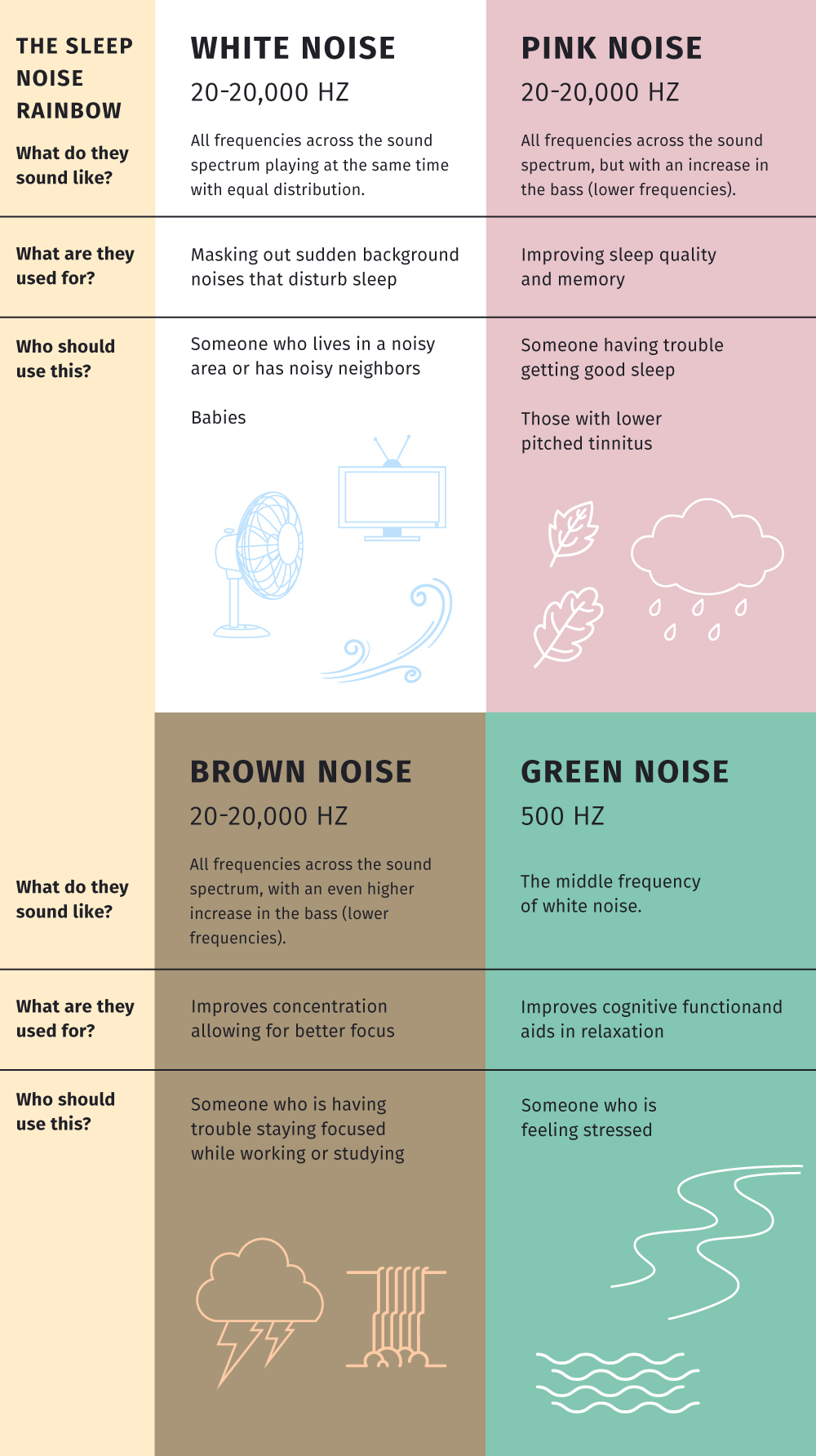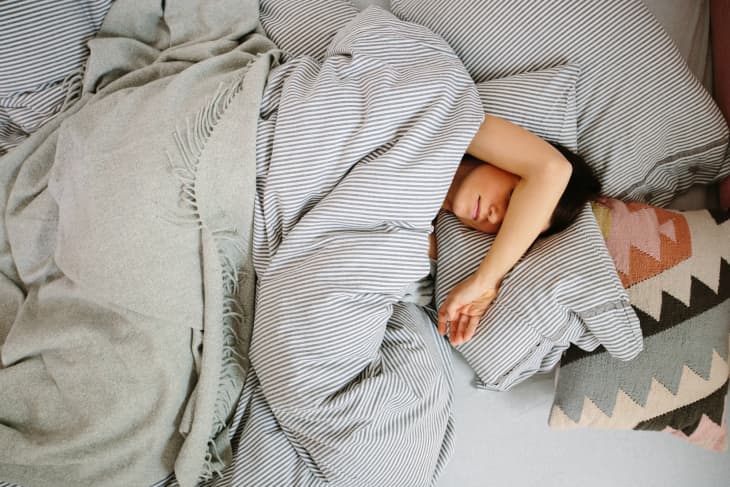Have you ever found yourself drifting off to sleep to the gentle hum of a fan, or the soothing rush of a white noise machine? You’re not alone. Many people find that ambient sounds, often described as “color noise,” can help them fall asleep faster and sleep more soundly. But with a whole spectrum of colors available, from white noise to pink noise and beyond, you might be wondering: which one is best for you?

Image: www.mattressclarity.com
This article will delve into the fascinating world of color noise, explaining the science behind these sounds and how they affect our brains and bodies. We’ll explore the unique characteristics of each color noise, guide you through finding the perfect sound for your sleep needs, and uncover what the latest research suggests about the best color noise for inducing a peaceful slumber.
Understanding Color Noise: A Spectrum of Sounds
Color noise refers to a type of sound that has a specific frequency distribution. Imagine a rainbow, where each color represents a different frequency of visible light. Similarly, color noise encompasses a range of sounds, each with its own unique frequency characteristics. The most popular colors include:
White Noise
Think of a static television screen – that’s the sound of white noise. It contains all frequencies of sound at equal intensity, resulting in a consistent, high-pitched hum. White noise is often described as “hissing” or “buzzing,” and it can be very effective at masking distracting sounds, like traffic or neighbors.
Pink Noise
Pink noise is like white noise, but with more energy at lower frequencies. It has a deeper, warmer sound that is often described as a “whoosh” or “rumble.” Some people find this sound more relaxing than white noise, as it is gentler on the ears and less likely to trigger anxiety.

Image: www.apartmenttherapy.com
Brown Noise
Brown noise, also known as red noise, has even more energy at lower frequencies than pink noise. It creates a deep, rumbling sound that some people find very soothing, even hypnotic. This low-frequency sound is often compared to the sound of a gentle waterfall or heavy rain.
Gray Noise
Gray noise is similar to white noise but with a more balanced frequency distribution. It’s designed to be more pleasant to the ears, with less of the harshness that some people find off-putting in white noise. Think of it as a more neutral, less “bright” sound.
Why Does Color Noise Help Us Sleep?
The benefits of color noise for sleep are rooted in its ability to mask distractions and promote relaxation. Here’s a closer look at the mechanisms at play:
1. Masking Distractions
Our brains are constantly bombarded by stimuli, both external and internal. Even seemingly quiet environments can hold distracting sounds, such as traffic noise, the hum of the fridge, or even our own thoughts. Color noise acts as a “blanket” over these distracting sounds, effectively blocking them out and preventing them from interfering with our sleep.
2. Promoting Relaxation
Color noise can induce relaxation through several pathways:
- Reducing Brainwave Activity: Studies have shown that listening to white noise can decrease beta wave activity in the brain, which is associated with wakefulness and alertness. This shift toward more relaxed brainwaves can facilitate sleep onset.
- Calming the Nervous System: The consistent nature of color noise can be very calming for the nervous system. By providing a constant input, it helps to reduce stress, anxiety, and racing thoughts, which often keep us awake at night.
- Creating a Sleep-Inducing Environment: Color noise can help to create a more peaceful and sleep-conducive environment by masking distracting sounds and reducing sensory overload.
Choosing the Right Color Noise for You
The best color noise for sleep is a personal preference. There’s no one-size-fits-all approach, and what works for one person might not work for another. Here are some factors to consider when choosing your perfect sound:
1. Personal Preference
The most important factor is your personal preference. Experiment with different types of color noise and see which one you find most soothing and relaxing.
2. Sleep Needs
Consider your specific sleep needs when choosing a color noise. For example, if you struggle with insomnia or difficulty falling asleep, you might find that pink noise or brown noise is more effective than white noise. If you need to block out distracting sounds, white noise might be a better choice.
3. Listening Environment
The listening environment can also influence your choice of color noise. For example, if you’re in a quiet room, a gentle sound like brown noise might be more effective. If you’re in a noisy environment, you might need a louder, more intense sound like white noise.
Latest Research on Color Noise and Sleep
Recent research is revealing new insights into the benefits of color noise for sleep. For instance, one study published in the journal *Sleep* found that listening to pink noise for 30 minutes before bed significantly improved sleep quality in participants with insomnia. The researchers suggest that pink noise may be particularly effective at reducing arousal and promoting relaxation.
Another study, published in the journal *Nature* in 2022, demonstrated that the specific frequency range of pink noise can influence the brain’s response to auditory stimuli. The study found that pink noise with a frequency range of 100-150 Hz helped to synchronize neural activity in the brain, potentially contributing to deeper sleep.
Tips for Using Color Noise for Sleep
Here are some practical tips for incorporating color noise into your sleep routine:
- Start with low volume: Begin with a low volume level and gradually increase it if needed.
- Experiment with different sounds: Try different color noises, such as white noise, pink noise, and brown noise, to find what works best for you.
- Use a dedicated sleep app or sound machine: There are many apps and sound machines available that offer a wide variety of color noise options.
- Create a consistent sleep routine: Try to incorporate color noise into your bedtime routine for consistency and optimal sleep benefits.
- Listen through headphones or a speaker: Whether you use headphones or a speaker will depend on your personal preference. Headphones can provide a more immersive and private listening experience, while a speaker can create a more ambient sound.
What Color Noise Is Best For Sleep
Conclusion
From the soothing hum of white noise to the deep rumble of brown noise, color noise offers a spectrum of sounds that can be beneficial for sleep. By masking distractions, promoting relaxation, and creating a more conducive sleep environment, color noise can help you fall asleep faster and sleep more soundly. Remember to experiment with different types of color noise to find what works best for you, and consider incorporating it into your regular sleep routine for a more restful night’s sleep.





